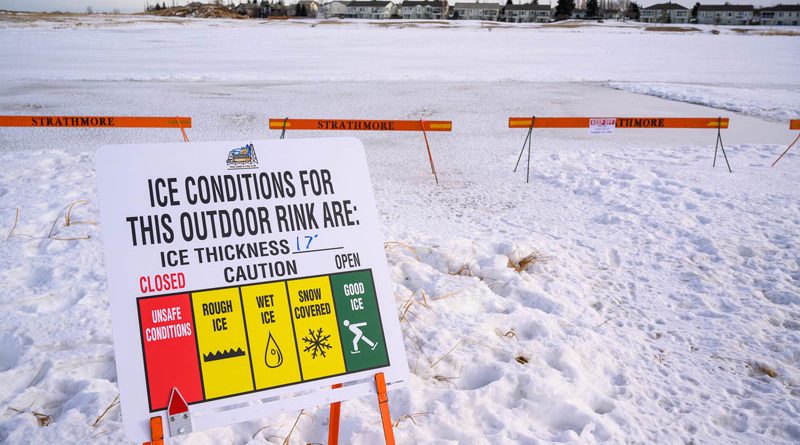Not all ponds created equal for skating
By Sean Feagan, Local Journalism Initiative Reporter

Sean Feagan Photo
While some areas of Strathmore’s storm ponds provide a safe place to skate, other spots have unreliable ice because of flowing water underneath the ice surface.
The recreational potential and safety of Strathmore’s storm water ponds was discussed during the town council meeting on Jan. 21.
Strathmore has a complex stormwater system featuring numerous ponds designed to collect water from impermeable surfaces during rain and melting events. While these water bodies typically freeze over in the winter, the ice can be inconsistent in some areas because of flowing water, creating hazards for skaters and town staff, explained Jim Simpson, the town’s interim director of infrastructure, operations and development services.
“We want to ensure the pond is safe for equipment and people on the pond,” said Simpson during the meeting. “I love the fact that people are out there cleaning and allowing their kids to go skating, but we cannot get around the fact that this is a storm pond, and the water is flowing.”
On Jan. 15, there was a report of a child falling through the ice of the Kinniburgh Storm Pond in Chestermere. While they left the scene unharmed, the event shows the potential risk of storm ponds in the winter, said Simpson.
“The town is not playing grinch on this,” he said.
Much of the controversy centres around Strathmore Lakes storm pond where, on Jan. 16, a Zamboni was brought in to clear and flood the ice, creating multiple rinks and numerous pathways.
However, town administration asserts many of these areas are not safe. Unlike Kinsmen Lake, where much of the entire surface may be skated on safely, Strathmore Lakes has six inlets but only one outlet, meaning there is higher inflow, and therefore a greater chance of poor ice in some spots, explained Donna McCallum, the town’s manager of operations. One of the inlets on the northwest side of the pond has water running through it year-round.
An important consideration for safety is ice quality, rather than just ice thickness, explained McCallum. In the beginning of the year, the ice is what is called snow ice, a mixture of ice and snow that contains air bubbles and is inconsistent. Later in the year, clear, blue ice forms, which is the safest type of ice.
The town started assessing the ice at Strathmore Lakes on Dec. 17, when the ice was nine to 10 inches thick but deemed to be poor quality (e.g., snow ice). The ice was assessed daily until the snowstorm on Dec. 21 to 22. The town started measuring again on Jan. 4, when the ice was deemed to be thicker but still poor quality. The quality of the ice started to improve on Jan. 11 when clear, blue ice was discovered in the pond’s southwest where skating is now permitted.
The town has restricted skating to a barricaded area in this southwest portion of the pond. In this area, ice thickness and quality are safe for people to skate and equipment to clean the surface without breaking through, Simpson explained.
McCallum said the town could clear more of this safe area for skating by putting an additional rink or two between the two that are there now. This would provide more space to meet a greater demand because of other activities being disrupted by the COVID-19 pandemic.
This demand has made the town look to other areas to provide skating venues for residents as well.
Rinks have been constructed in the past in some of the town’s dry ponds, features designed to temporarily hold meltwater. But the town wants to avoid this because the rinks can interfere with spring drainage.
“It may be difficult for the water to get away,” said Simpson.
Instead, the operations department is considering a pilot project to provide ice surfaces in public greenspaces, away from stormwater infrastructure, said McCallum.
The discussion was associated with a new town policy about the recreational use of storm water ponds, and an associated parks and pathways bylaw amendment, but this was retracted by administration and will be presented to council for consideration at a later date.
